Archives - Page 2
-

The New Children of the Sun
Vol. 25 No. 41 (1993)January to June 1993.
Young people are also present in the academic debate raised by the magazine. In this issue, entitled the new children of the Sun, we find numerous works that together offer us the possibility of approaching youth subjectivity at a crucial moment in Peruvian history at the end of the century. In this sense, the volume begins with a debate on the memories, forgetfulness and misunderstandings related to the subjectivity of young Andeans.
-

The Power of the Sacred
Vol. 24 No. 40 (1992)July to December 1992.
In a context marked by the so-called Crisis of Civilization, this volume provides us, through different studies of interest, the necessary elements to see how much some elements of the sacred are being expressed as factors of power in the Andean territories. Ten years after publishing an issue on religion, myth and rituals in the Andes, the magazine returns to its old privileges, but from new perspectives and coordinates.
-
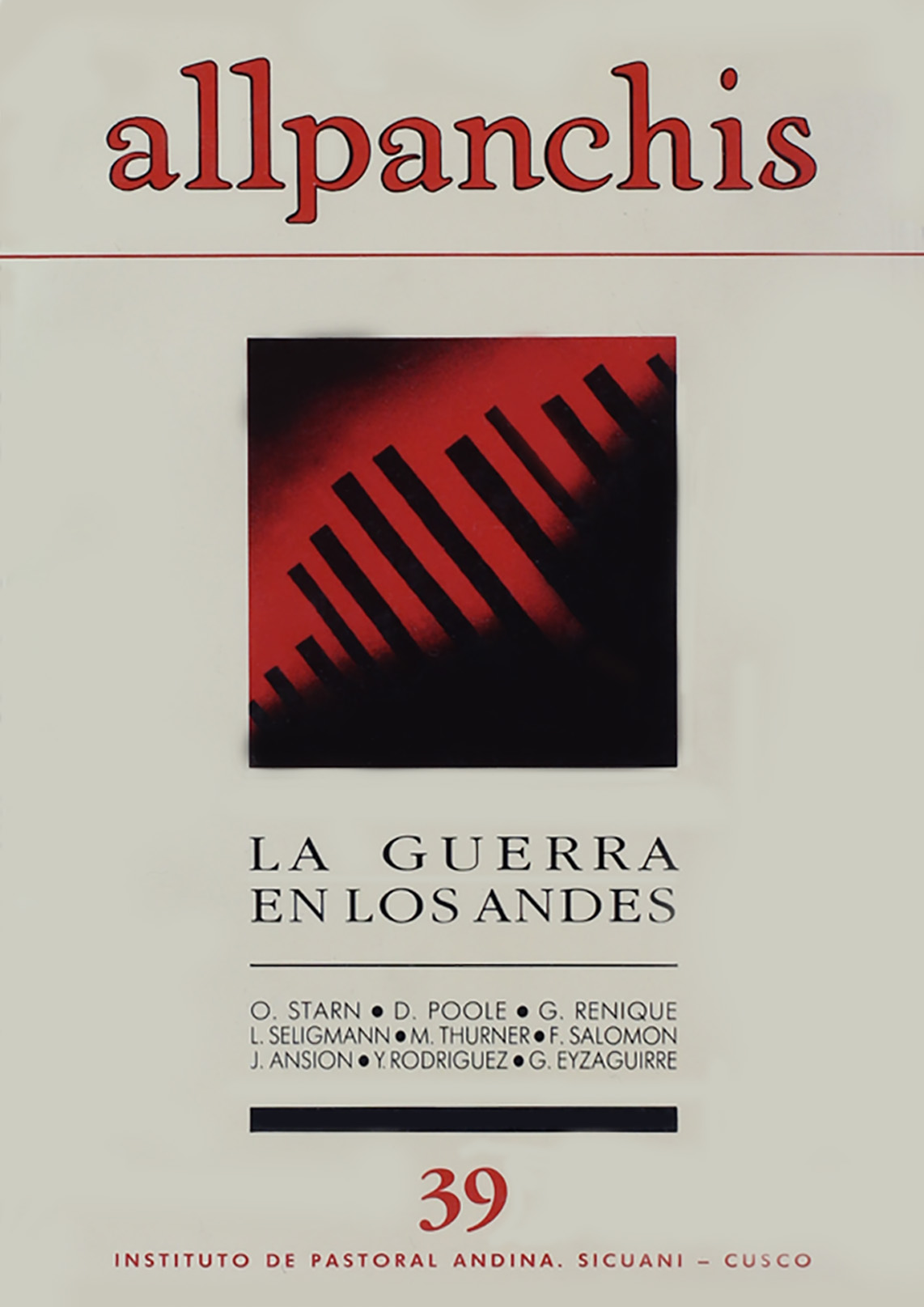
The War in the Andes
Vol. 24 No. 39 (1992)January to June 1992.
Returning to the subject of academic debates, this issue addresses a fundamental problem on which there are still very few studies: the peasantry and political violence in the Andes. The present debate was provoked by a controversial article written by the North American anthropologist Orin Starn, on the neglect of anthropology in the face of the Senderista phenomenon; the same that will be commented and criticized by specialists such as Frank Salomon, Mark Thurner, Deborah Poole and Gerardo Renique.
-
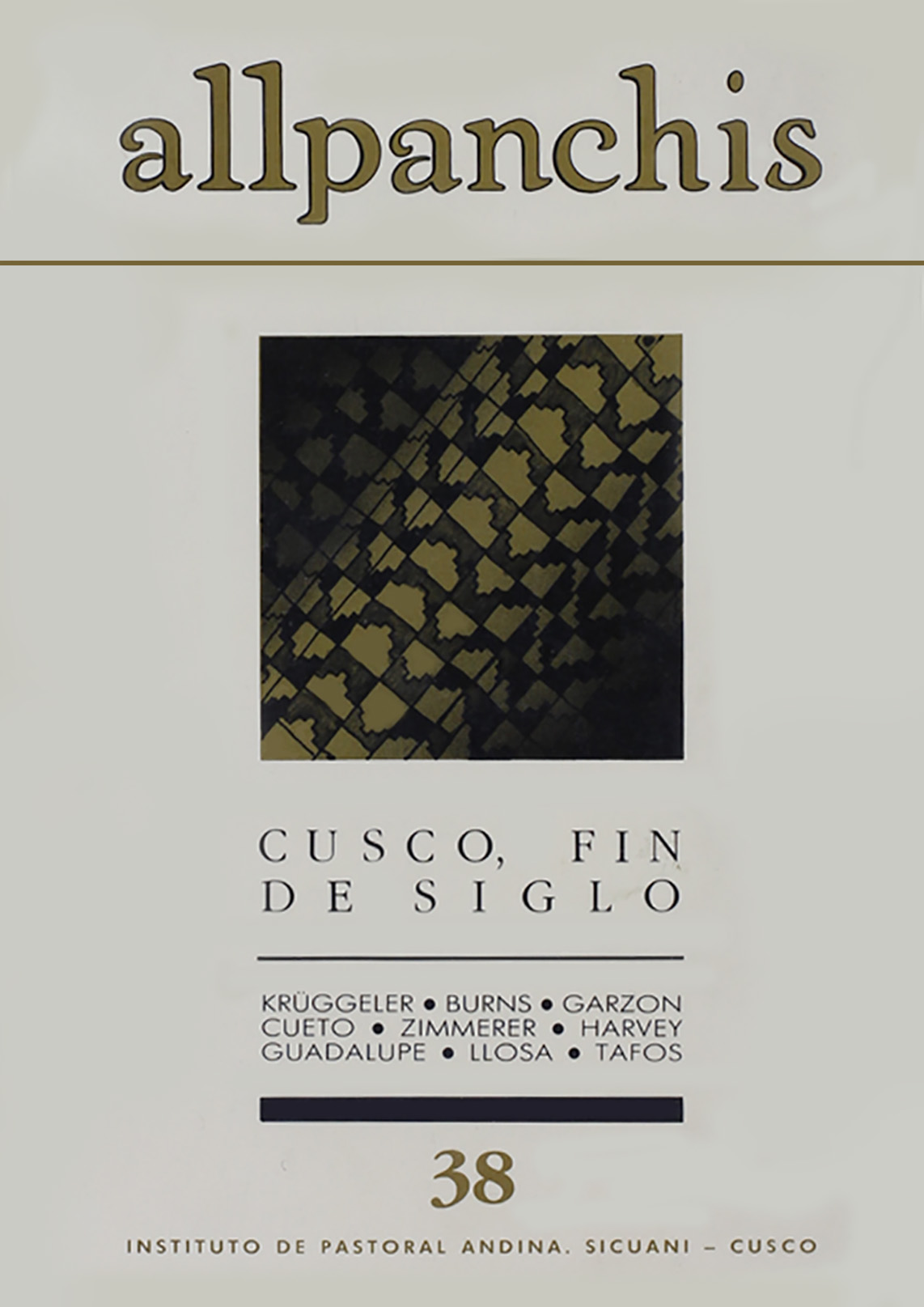
Cusco, end of the century chronicles
Vol. 23 No. 38 (1991)July to December 1991.
With this issue, the magazine ends a series that was dedicated to the Fifth Centennial and its relationship with the Andean territories. This edition offers a good number of articles related to the Cusco region. They are divided into two groups of studies, related to the urban and rural world. The themes of artisans, picanterías and conventual life stand out.
-
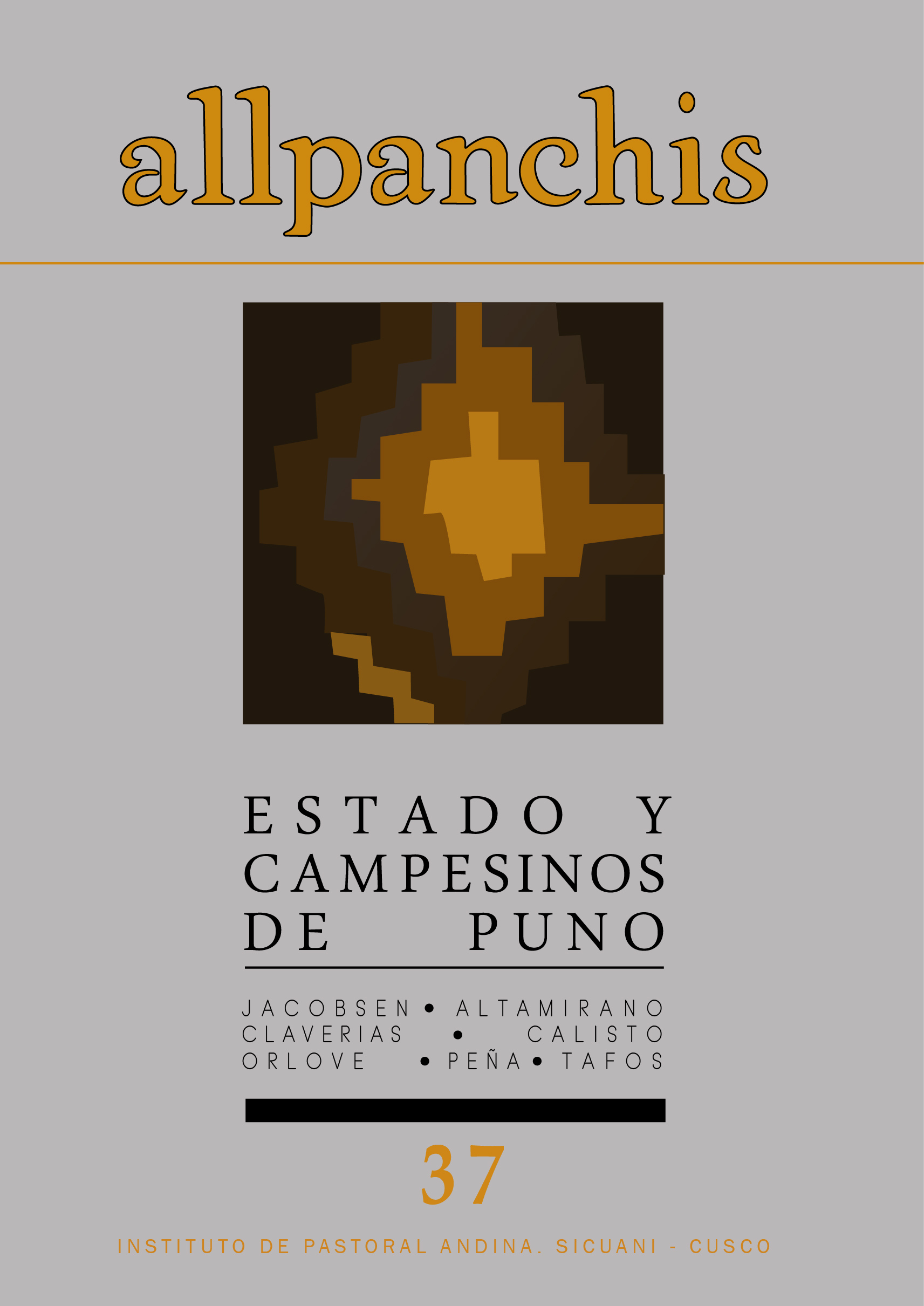
State and Peasants of Puno
Vol. 23 No. 37 (1991)January to June 1991.
Within the reflective line around the Fifth Centennial, this number provides through different lenses a panoramic vision of the economy and society of the department of Puno from the end of the 18th century to the mid-20th century. Throughout this journey, the peasant community appears as an irrefutable force and truth. However, and this is what never ceases to surprise, it still has long-standing rural problems.
-
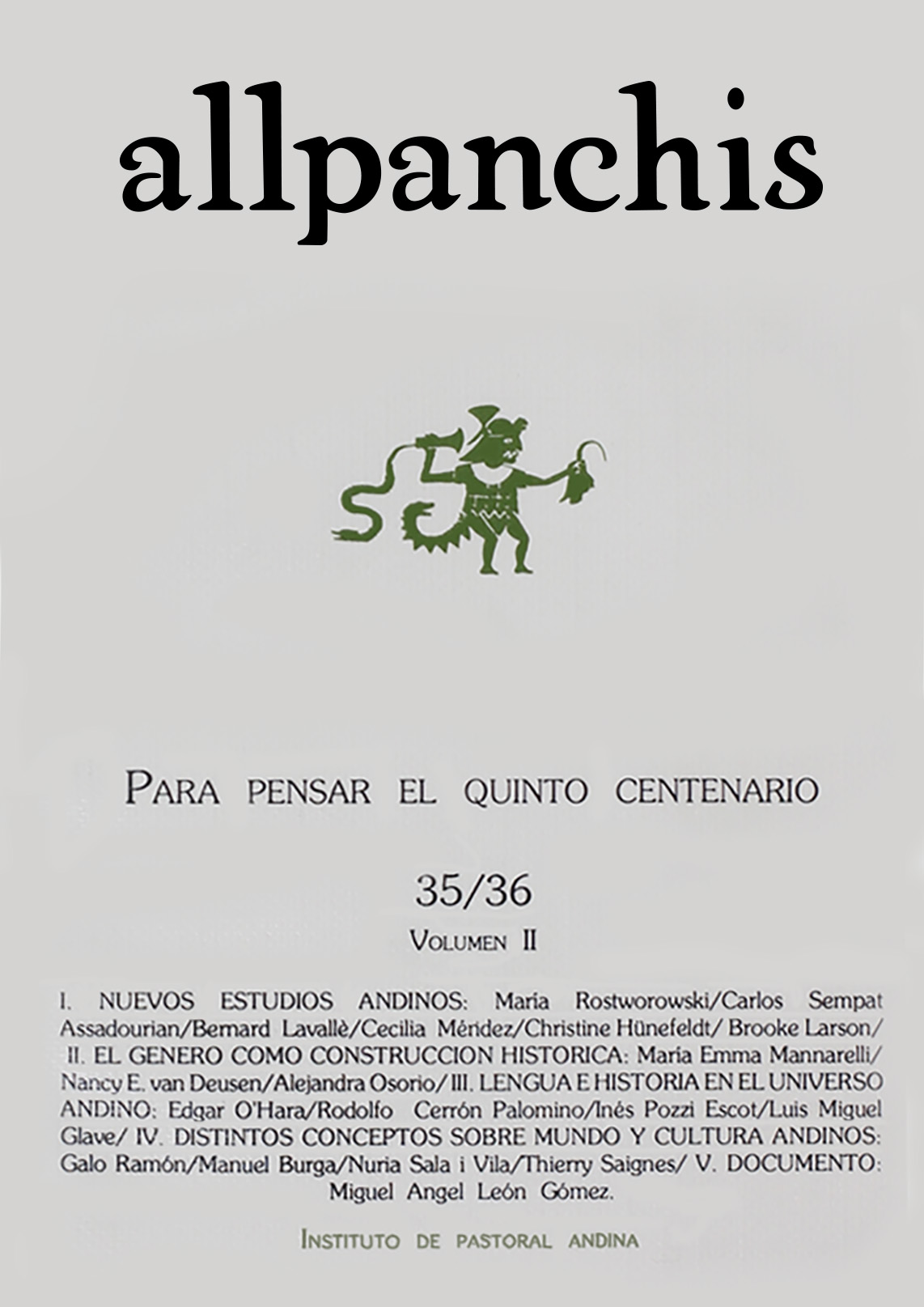
Para Pensar el Quinto Centenario (II)
Vol. 22 No. 36B (1990)January to December 1990.
In the first of the volumes we find significant contributions in relation to the new Andean studies and the question of gender as a historical construction, starting from the pre-Hispanic period until reaching the 19th century. In the second volume, the subject of language and education is basically addressed, as well as the different concepts that exist and are handled about the Andean world and culture.
-
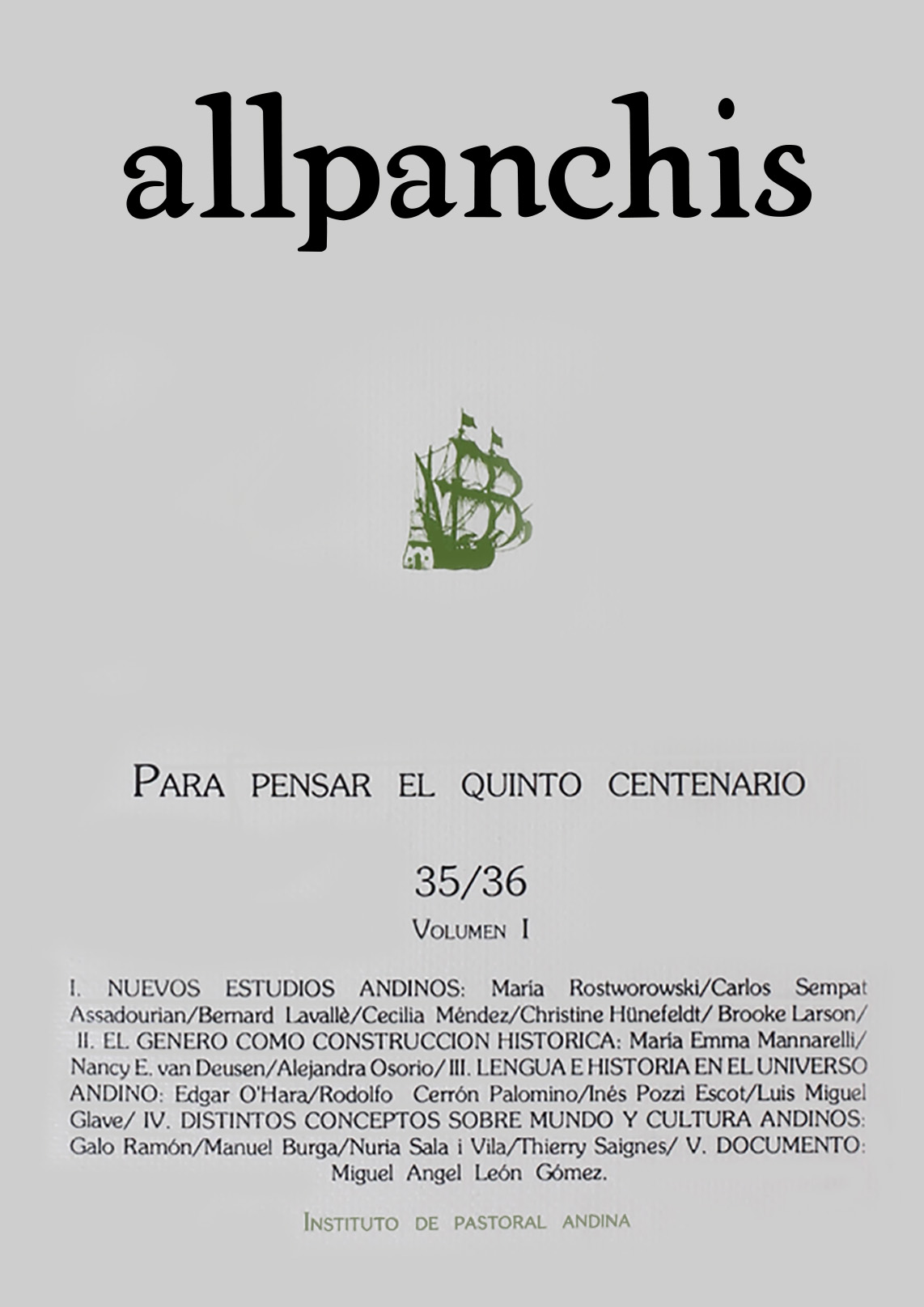
Para Pensar el Quinto Centenario (I)
Vol. 22 No. 35/36 (1990)January to December 1990.
It is a double number presented in two volumes, whose main tenor revolves around the celebration of the Fifth Centennial of the arrival of Columbus to American lands. In this sense, specialists in the field of history, literature and linguistics contribute different works in order to reflect on our history and identity. The organizers of the issue intend to "discover" from the present the America that has been built in the last 500 years.
-
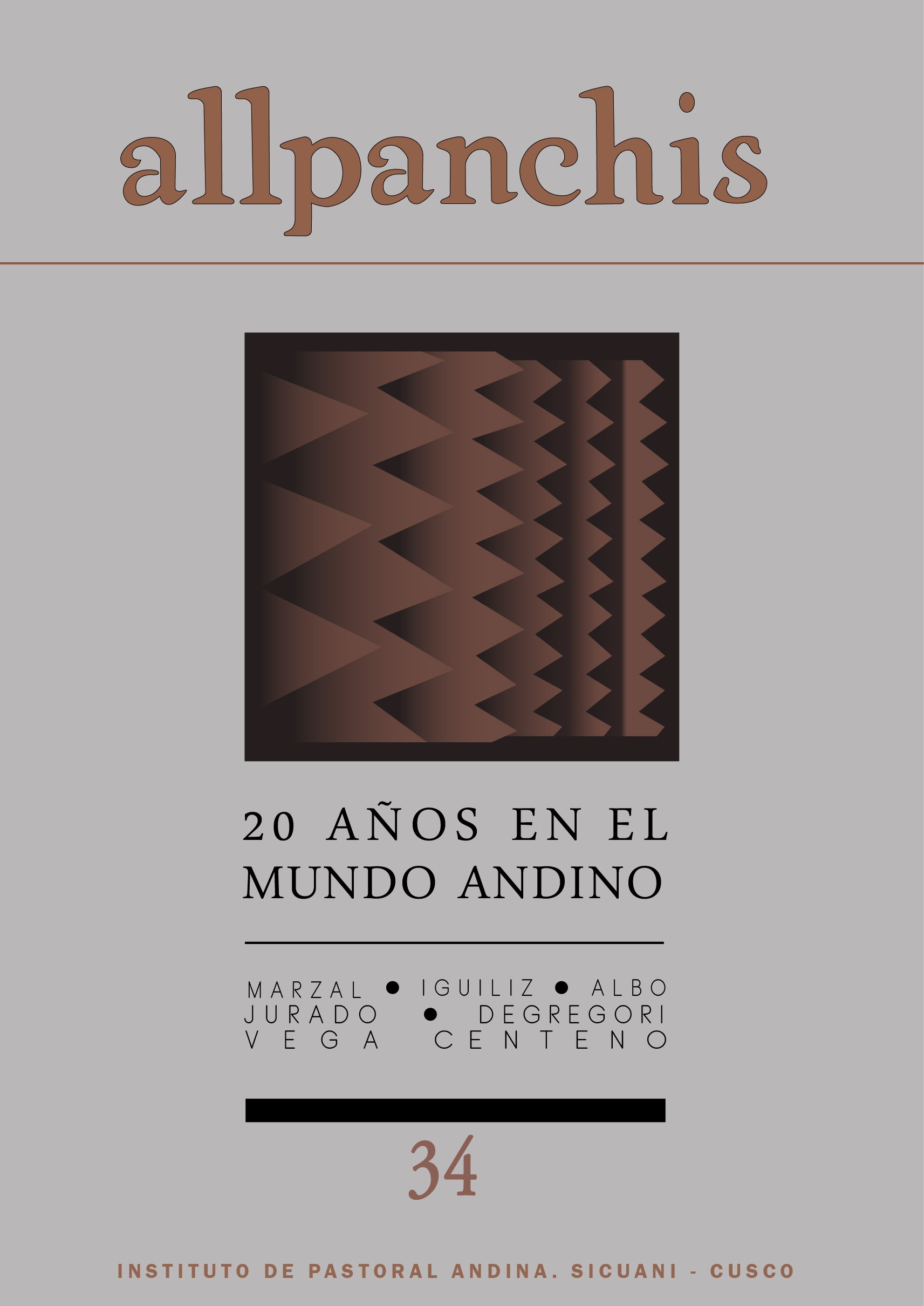
20 Years in the Andean World
Vol. 21 No. 34 (1989)July to December 1989.
The 20 years of Allpanchis magazine could not go unnoticed by its directors, so a tribute number was conceived. There, recognized intellectuals and regular collaborators offer a tight balance about the situation of some topics debated throughout these two decades: Andean religion, the southern region, the peasantry and the political violence that was particularly experienced in the decade
-

Power and Authority in the Andes
Vol. 21 No. 33 (1989)January to June 1989.
This number coincides with the 20 years of the Andean Pastoral Institute. For this reason, the magazine presents authors who reflect on the way in which power and authority has been and is exercised in the Andes. The underlying editorial objective is to present texts that break with the idea of considering the Andean peasant "as a normally apolitical subject who only knows how to react", as historian Charles Walker asserts.
-

Andean Religiosity
Vol. 20 No. 32 (1988)July to December 1988.
A new issue on a subject of great cultural and academic vitality such as Andean religiosity. Focusing on both the past and the present, various studies show the validity of some religious practices and expressions, while presenting the Andean as a dynamic factor that is revealed with multiple values and singularities, interpreted as facets of the universality of Christianity.
-

Andean Religiosity
Vol. 20 No. 31 (1988)January to June 1988.
With this issue, the magazine inaugurates a new presentation, although without giving up its recognized studies and interests, such as Andean religiosity, which is the subject of this presentation. Through substantial articles, it seeks to explore the complex processes of integration between Andean and Hispanic traditions, as living currents of religious experience. Likewise, the number presents attractive descriptions of rites and beliefs in force in the Andean world.
-

Nation Language and Andean World
Vol. 19 No. 29/30 (1987)January to December 1987.
Voluminous double number (more than 600 pages) and collection, referring to the subject of the language, the nation and the Andean world. There, renowned specialists address the subject of language in relation to society, politics and culture. Likewise, there is a very interesting debate on bilingual education in Peru and the problem of writing and the alphabet around Quechua and Aymara.
-

Antiquity and Actuality of Irrigation in the Andes (II)
Vol. 18 No. 28 (1986)July to December 1986.
Much closer to our time, this second volume analyzes the problem of irrigation from different perspectives and contemporary institutions, highlighting the relationships between communities and the State. This also seeks to reach a long-term analysis of the various strategies developed by some communities in order to access and rationally use this valuable resource, in which the ceremonies and propitiatory rites were not absent.
-
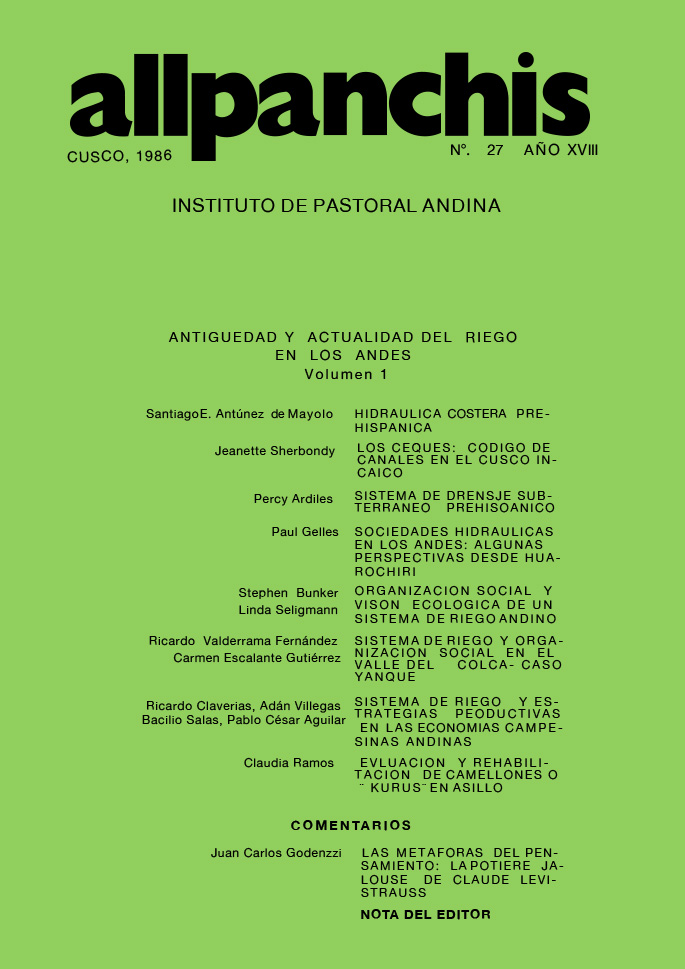
Antiquity and Present of Irrigation in the Andes (I)
Vol. 18 No. 27 (1986)January to June 1986.
This number corresponds to the first of two volumes in which the validity and actuality of ancient irrigation practices in the Andes is addressed as a central axis. It includes interesting articles referring to pre-Hispanic coastal hydraulics, the relationship between the ceque system and the canals in the imperial capital, the underground drainage systems used by the Incas in the city of Cuzco and an approach to the so-called past and present hydraulic societies .
-

Conflict and Peasants in Andean Mining
Vol. 17 No. 26 (1985)July to December 1985.
This issue is aimed at studying the presence of the peasant in Andean mining and the relationships of violence and conflict that affect him. Through a dozen articles, the magazine offers us a significant variety of situations that allow us to reconstruct an entire panorama, vast and complex, around the relations of the Peruvian peasant with the mining activity, in which the contradictions and contradictions are not absent. iniquities.
-
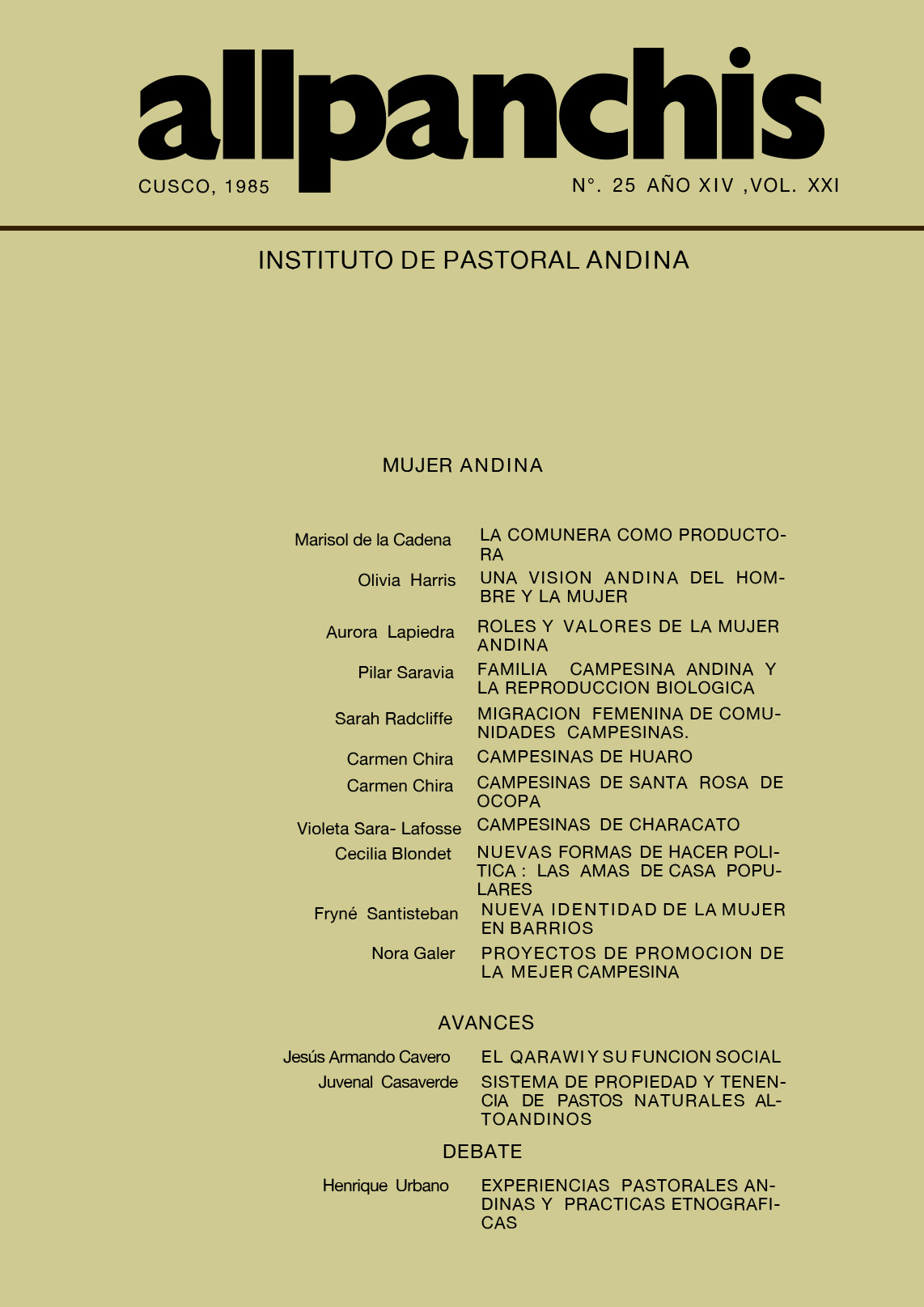
Andean Woman
Vol. 17 No. 25 (1985)January to June 1985.
The issue of Andean women could not be absent from the debate proposed by this magazine. A group of female specialists address the problem in its multiple dimensions: as producers, depositories and transmitters of cultural values, as migrants and as central agents in the conquest of new, family, communal or neighborhood spaces. Likewise, the studies highlight their importance as active agents in regional development, in the midst of the crisis of the eighties.
-

Approach to the Andean World from the Ecclesial Task
Vol. 16 No. 24 (1984)July to December 1984.
Taking as a setting, the pastoral visit of Pope John Paul II to Peru, this issue leaves aside the usual scientific research studies, to provide us with testimonies of Christian life from some lay pastoral agents, who transmit their experiences and daily experiences within the communities, a convenient reflection on the Andean social reality today.
-

The Andes as a possibility
Vol. 16 No. 23 (1984)January to June 1984.
From this issue on, the magazine's direction fell to economist Javier Iguíñiz Echeverría. In this edition, some interesting proposals are made about the promotion and development of agricultural, livestock and craft activities in certain regions. It also addresses interesting aspects about the religion of the Andean man and his worldview.
-

Peasant Communities: Land and Society
Vol. 15 No. 22 (1983)July to December 1983.
The topic of peasant communities is taken up in this issue, which has the collaboration of renowned specialists on social organization and peasant conflicts, the land ownership regime and water control, the family economy within the system capitalist and a study on the region covered by the old Tarma Intendancy in the first 50 years of independent life.
-
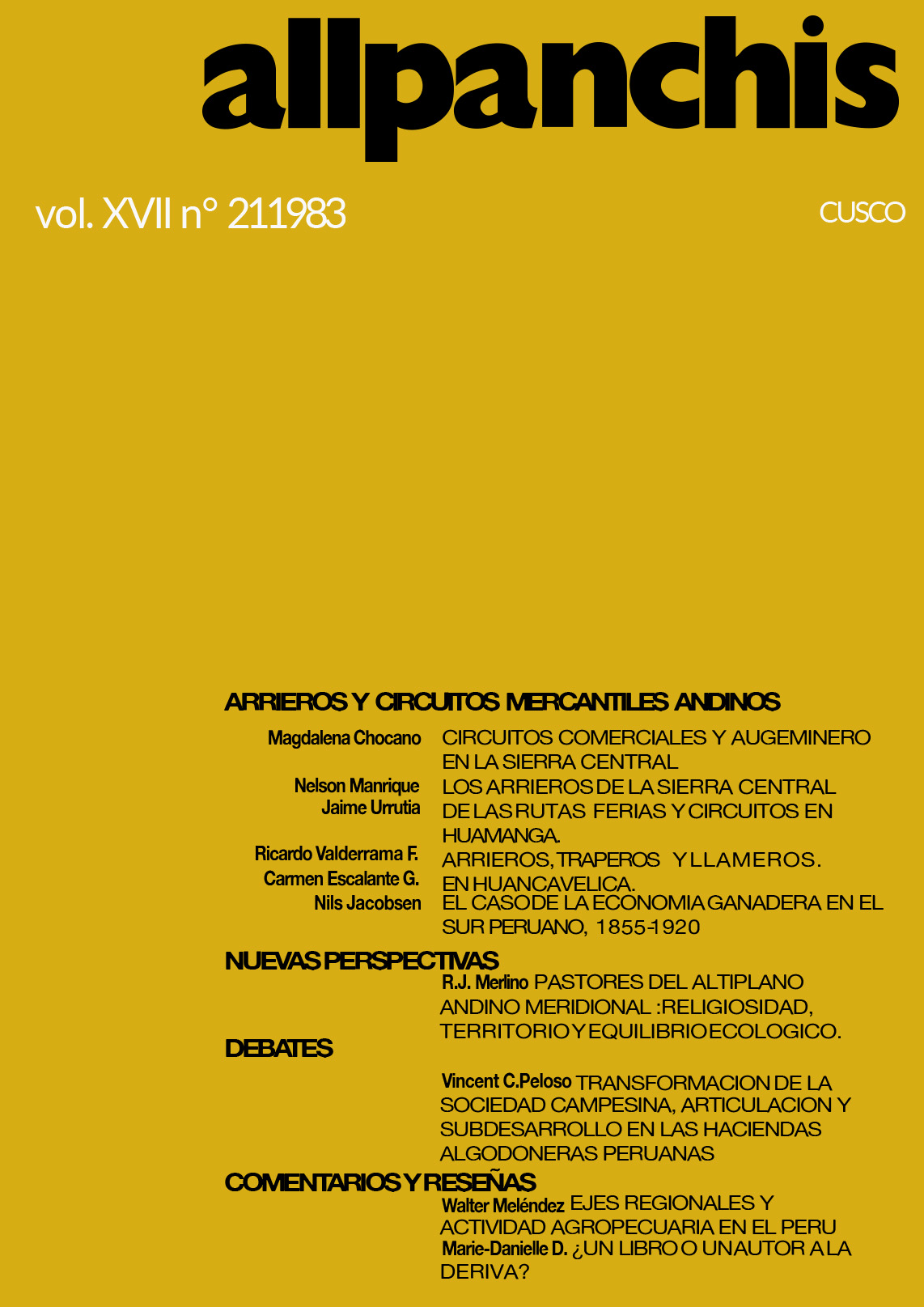
Arrieros and Andean Mercantile Circuits
Vol. 15 No. 21 (1983)January to June 1983.
Interesting number about the dynamics of Andean commercial circuits in the post-independence period, as well as the various transportation systems that made it possible. In this way, the action of muleteers, herdsmen and llama drivers is studied. The studies are circumscribed to the Central Sierra, Huamanga and Huancavelica, as well as the southern sierra, a region committed since the second half of the 19th century to the wool economy.
-

Region, Myth and Ritual in Peru
Vol. 14 No. 20 (1982)July to December 1982.
In this issue dedicated to religion, myth and rituals in Peru, the magazine once again takes up a theme raised in its tenth issue, this time with contributions about origin myths, collective representations and the mental archeology of the settlers. Andean. The Andean utopia, the truth-deception duality in Ayacucho myths, and the dynamics of the Indian brotherhoods are other topics discussed. The mythical discourse of the chronicler Juan Santa Cruz Pachacuti is analyzed by Alejandro Ortiz and, as a complement, a meticulous analysis of the tithes in the Huamanga Municipality.
-

El Cristianismo Colonial
Vol. 14 No. 19 (1982)January to June 1982.
The issue of colonial Christianity is addressed in this issue of the magazine. Although at first glance it could suppose a history of the Church as an institution, the authors seek to approximate the daily practices of a religion and the orthodox or heretical beliefs of Andean men. It addresses the daily practices of priests, doctriners and native faithful who starred in a process of profound transformation in religious beliefs, piety, values and rites through the evangelizing action of missionaries and a systematic fight against idolatries since the 16th century.
-
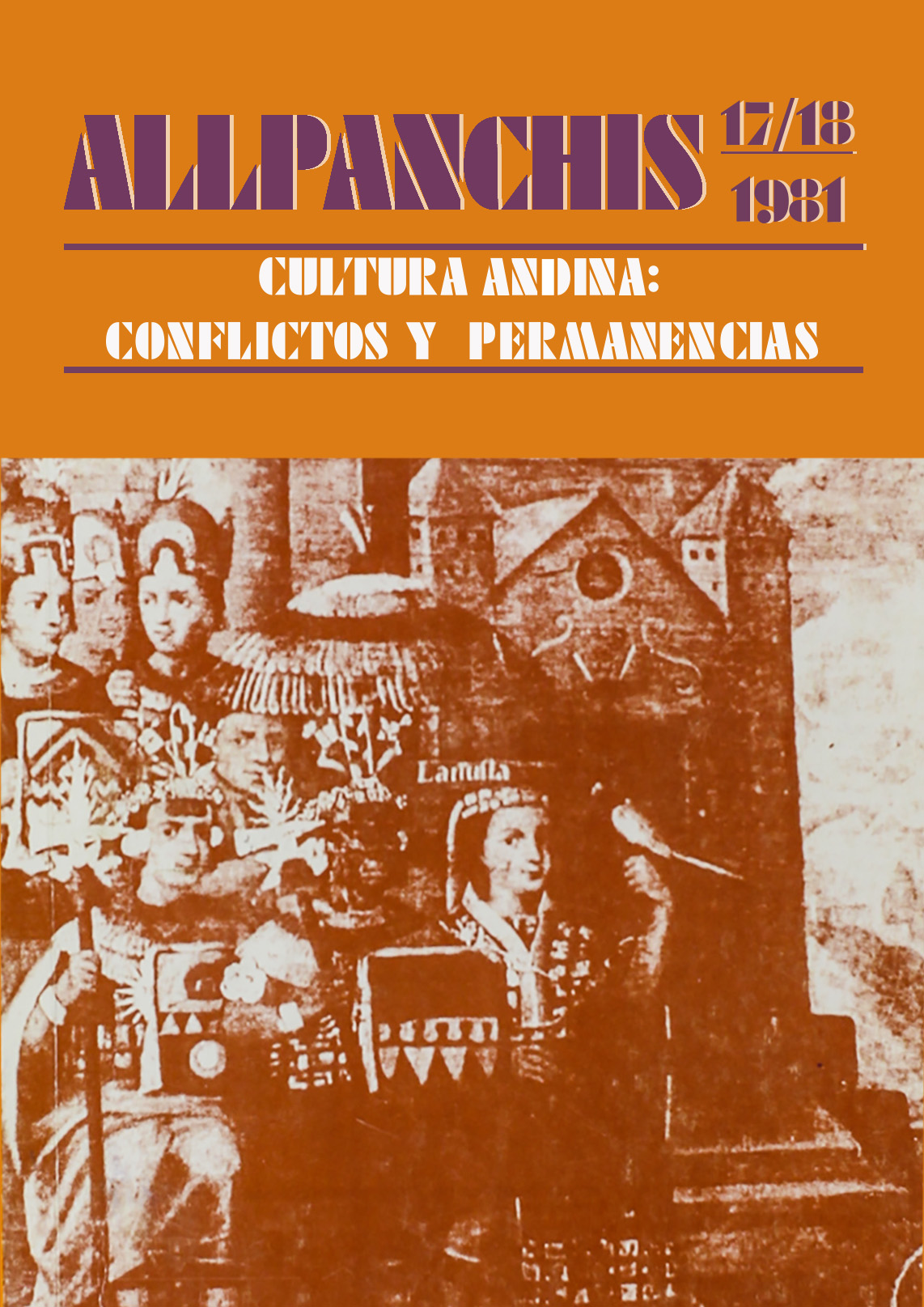
Andean Culture: Conflicts and Permanence
Vol. 13 No. 17/18 (1981)January to December 1981.
The complex issue of conflicts and permanence of Andean culture is addressed from different intellectual, geographical and chronological perspectives. This is not an easy task as it seeks to show the links between a dominated culture and a certain social structure, where the role of art was very important within social conflicts, such as those that occurred north of the Lima audience, exposed by Waldemar Espinoza Soriano. Likewise, this delivery is also a tribute to one of the most active and committed intellectuals on the subject: the writer and anthropologist José María Arguedas, from whom two important letters and an analysis of his work El zorro de arriba y el zorro de down.
-
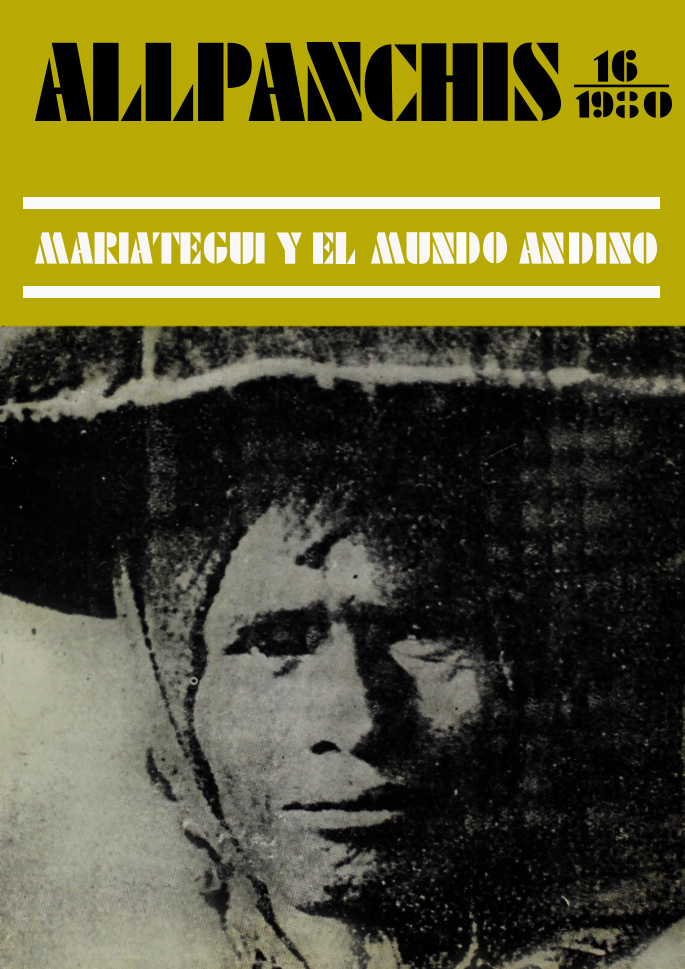
Mariategui and the Andean World
Vol. 12 No. 16 (1980)July to December 1980.
From different areas of academic and professional interest, this issue addresses the relationship between amauta José Carlos Mariátegui and the Andean world. However, it begins with a semblance of the work and figure of the historian Jorge Basadre, who died in the middle of the preparation of the issue. The works not only seek to rescue the relationship between Mariátegui and the Andean culture based on his already known approaches to the problem of the Indian, but also on his permanent ties with provincial intellectuals from Cusco, Puno and Jaujinos, in whose localities, since the decade of 1920, there was a fruitful intellectual life.
-

Andean Agriculture (II)
Vol. 12 No. 15 (1980)January to June 1980.
Continuing with the theme of Andean agriculture, this second part seeks to lead us to the pre-Hispanic period and, from a historical and archaeological perspective, presents suggestive studies on the formation of agricultural cultures in various periods in an environment as heterogeneous as ours. It includes different techniques of a hydraulic nature and regional experiences, such as those produced on the Peruvian coast or in the Junín highlands. Additionally, it offers a study on corn production in one of the most representative Cuzco valleys: Ollantaytambo.
-
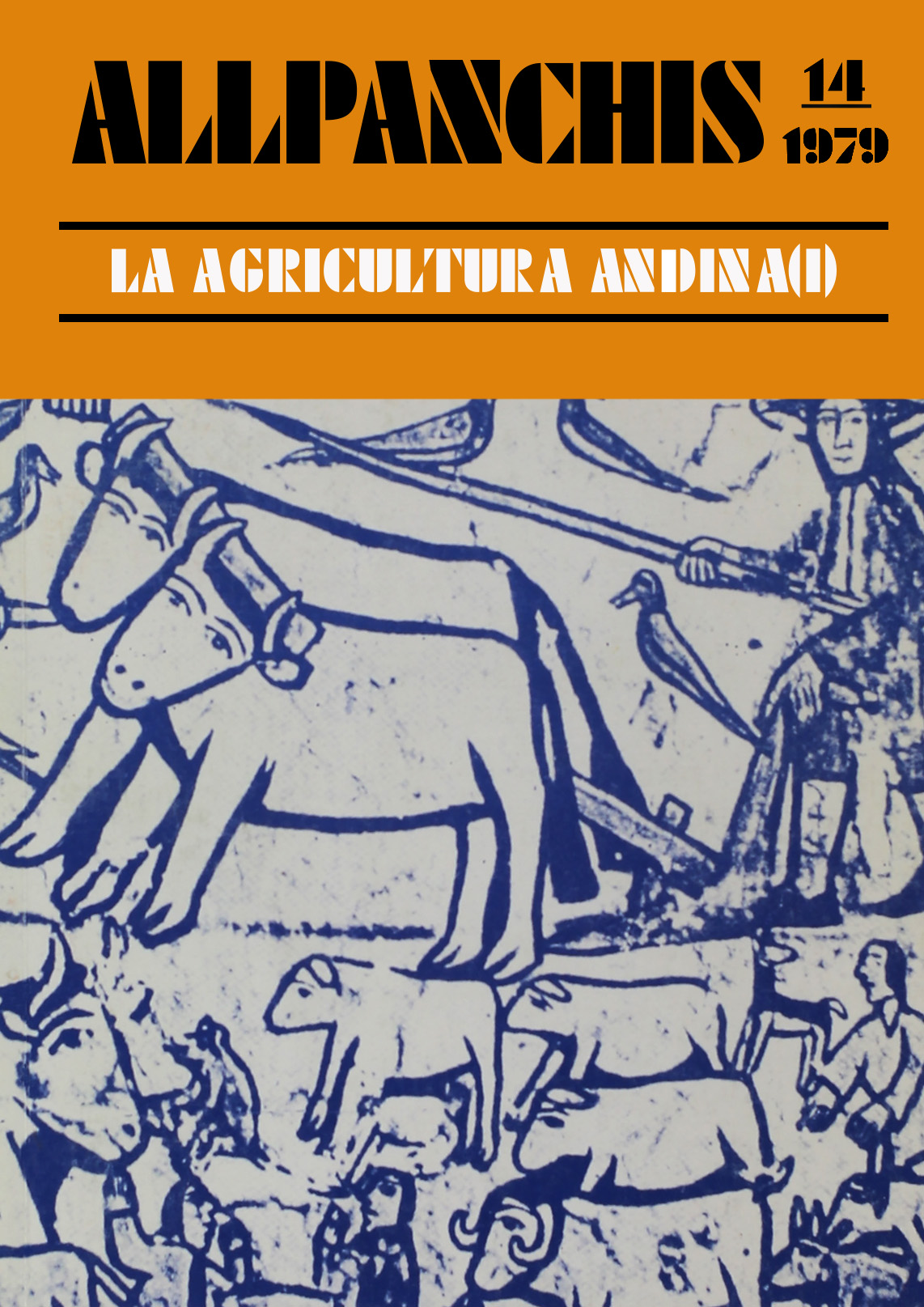
Andean Agriculture (I)
Vol. 11 No. 14 (1979)July to December 1979.
This number corresponds to the first part of a subject of ancient date, but also very present and studied, such as Andean agriculture. Through various studies focused from a rather contemporary perspective, it seeks to address some neglected issues regarding this activity: the situation of the peasant, prices and the relationship between the field and the city, the changes generated by agro-industrial companies, and finally the crops seen not only as natural phenomena but also in relation to the social systems, techniques, conceptions and culture of a country.
-
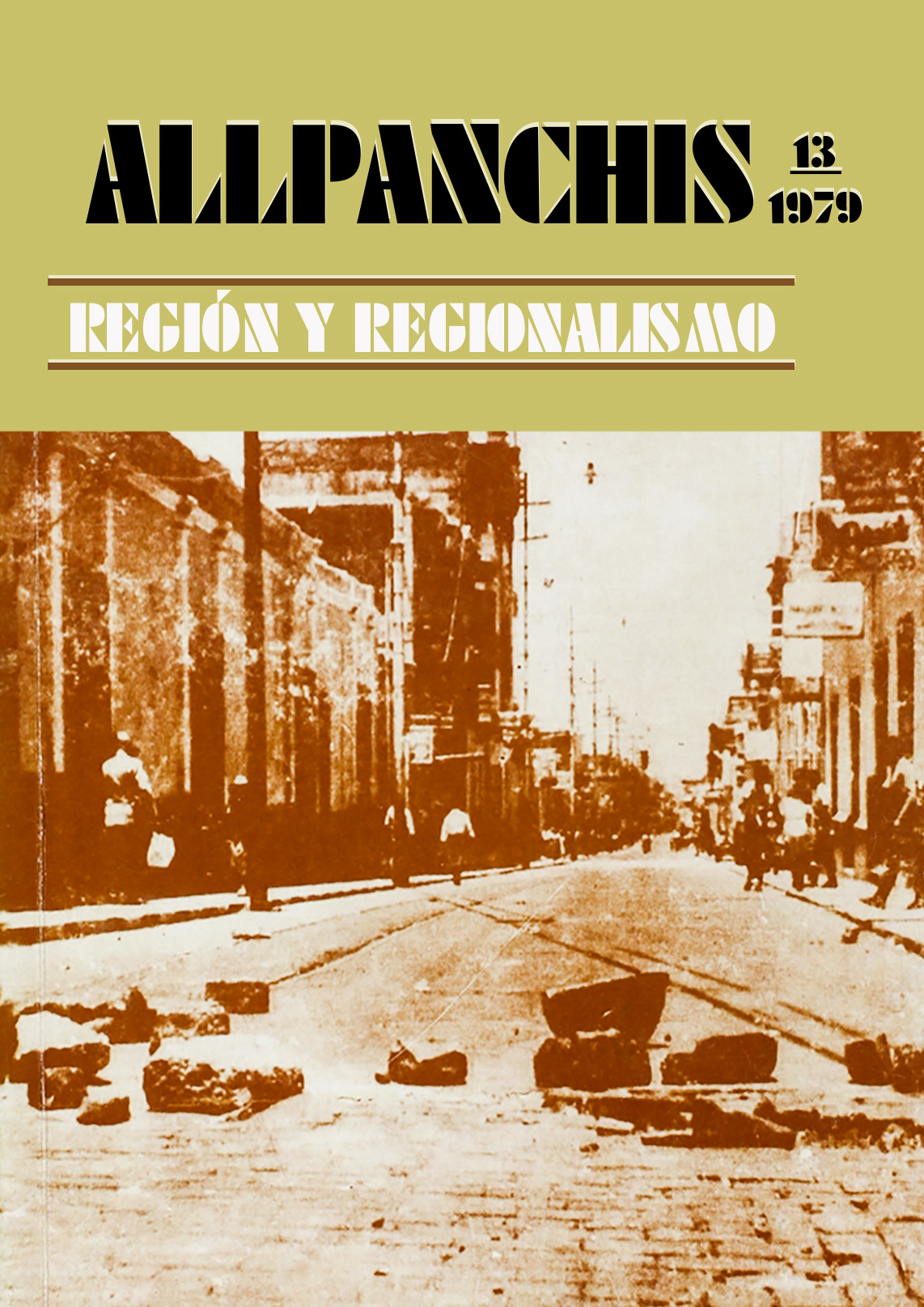
Region and Regionalism
Vol. 11 No. 13 (1979)January to June 1979.
It addresses the problem of the region (as a natural fact) and regionalism (as a cultural variant of the country in opposition to the central power) in the republican history of Peru, with a greater incidence in the twentieth century and some detail in the departments of the south, particularly Arequipa. Various articles focus on the factors of regionalism as an expression of social unrest, the hegemonic role of the popular classes, without neglecting the material bases that drive them, such as the development of the internal market.
-

Peasant Movements
Vol. 10 No. 11/12 (1978)January to December 1978.
From this double issue, the magazine's direction was the historian Alberto Flores Galindo. Presents a set of articles about peasant movements in Peru, which began in the 18th century and ended in the 20th century. With contributions from historians, anthropologists and sociologists, it seeks to go beyond the narration of such movements to delve into an explanation of them, based on the articulation between the various factors, political situations and social structures.
-

Myth and Utopia in the Andes
Vol. 9 No. 10 (1977)January to December 1977.
One of the most celebrated issues of the magazine and has more than one edition. It deals with a subject of great impact at the end of the last century, among historians, anthropologists and sociologists: myth and utopia in the Andes. Renowned researchers address the theme of myth and history, myths of origin in different communities, the recreation of myths from crisis cults, from Taki Onqoy to Inkarri. It also presents a study on the different names in Quechua for Viracocha, an ancestral Andean divinity, considered as Creator God by the early evangelizers.
-

Andean Rites and Rituals
Vol. 8 No. 9 (1976)January to December 1976.
This issue seeks to synthesize the contributions of previous issues in relation to the theme of Andean ritual; that is to say, the survival of certain Inca rites beyond the movements of extirpation, the reasons that have allowed their survival or the reasons that led to their disappearance. We find studies on Andean astronomy, language and gesture, the Pachamama tinka, the Dispatch rite or payment of the land, as well as one of the most important ceremonies of the Inca period related to the sacrifice of human beings: the Capacocha.
-

Shepherds, Llamas and Alpacas
Vol. 7 No. 8 (1975)January to December 1975.
From this issue on, the magazine's management was assumed by the sociologist Henrique Osvaldo Urbano, replacing Juan Hugues. The theme revolves around the world of the llama and alpaca herders of the puna and includes studies about the domestication of animals, the economy and ritual, the relationships between shepherds and farmers, as well as magical beliefs and rites. religious in Puno shepherds and in other localities such as Moquegua (Peru) and Atacama (Argentina).
-

The Fiesta in the Andes
Vol. 6 No. 7 (1974)July to December 1974.
Edition dedicated to the Fiesta in the Andes, where its importance is highlighted, as a vehicle for social advancement for some individuals, an element of affirmation of the identity of a social group or of cultural distinction from other groups, as well as a mechanism for breaking the everyday, momentarily denying the social, economic or political situation to assume a completely opposite way of life, as if it were a parallel universe, where the rules, norms and codes are altered for a few days.
-
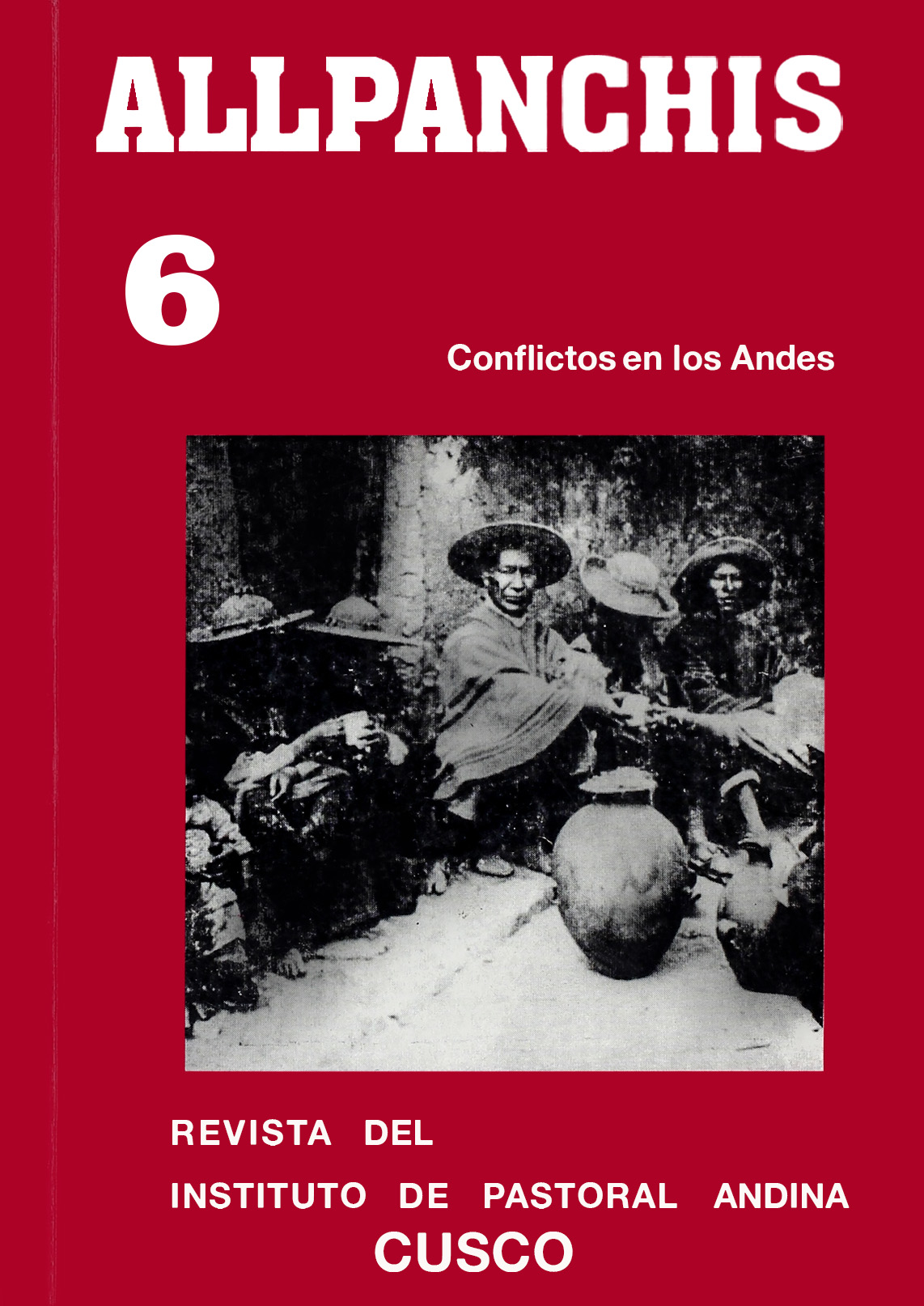
Conflicts in the Andes
Vol. 6 No. 6 (1974)January to June 1974.
This issue deals with the interpretations and descriptions of real conflicts and ideological and cultural conflicts of some peasant communities located throughout the Peruvian highlands, such as El Collao, Paucartambo, Anta and the Callejón de Huaylas. These conflicts occur between communities and farms, between the landowner and the colonist, or between the peasants of the same communities.
-

Life Cycle in the Andean Family
Vol. 5 No. 5 (1973)January to December 1973.
The theme of the previous edition on the life cycle in the Andean family continues, although it approaches it from a more external perspective. It addresses the social treatment between the Aymara, Andean exogamy, reciprocity and the market economy, as well as the impact of the agrarian reform on the cargo system, taking the Mexican and Bolivian cases as elements of comparison.
-

Life Cycle in the Andean Family
Vol. 4 No. 4 (1972)January to December 1972.
The main concern of this issue revolves around the life cycle of the Andean family, extracted from various cases taken from peasant communities in southern Peru and Bolivia, both in the Quechua and Aymara languages. This cycle is manifested through marriage, customs and rites, mortality, family union, women and even the exchange of women.
-

Agricultural and livestock rituals of the southern Andean
Vol. 3 No. 3 (1971)January to December 1971.
The number delves into the agricultural and livestock rites practiced in various southern Andean communities, linked to the so-called Natural Religion, which is characterized by granting great symbolic and sacred value to some elements such as the sun, stones, mountains and the land or Pachamama. These rites are also manifested in an implicit and explicit way within the Christian ceremonial.
-

The Andean supernatural world
Vol. 2 No. 2 (1970)January to December 1970.
Edition concerning the supernatural world, present in some native Quechua-speaking communities of the departments of Puno and Cusco, such as Qollana, Llavini, Urcos and Qotobamba. Various religious beliefs of pre-Hispanic origin that have survived are described, as well as philosophical concepts of the Andean worldview that allow us to scrutinize the soul of its inhabitants.
-

Costumbres y ritos religiosos en los Andes
Vol. 1 No. 1 (1969)January to December 1969.
Starting number of this magazine, where his great objective of knowing the Andean man is exposed to optimize pastoral tasks in the southern Peruvian highlands. According to its editors, the magazine will also seek to promote the cultural values of the Aymara and Quechua peoples of the southern Andean region. It presents a variety of themes that range from the peasant family to the survival of some characters such as the Ñaqaq or the traditional practices associated with the payment of land, the change of luck and the Feast of the Cross (or Cruz velakuy).




